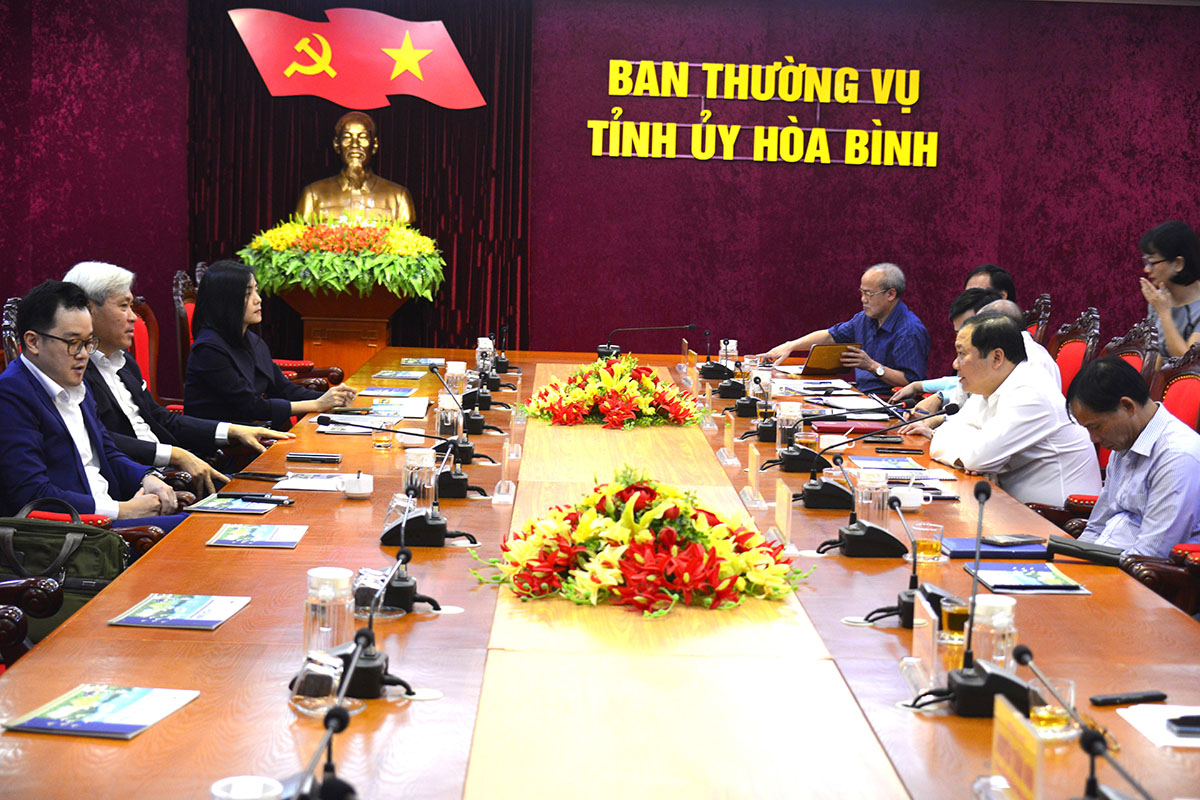
(HBO) – The Hoa Binh Party Committee on November 29 had a meeting with leaders of the VinaCapital Group regarding the latter’s proposal to research and invest in a project in the province. Present at the event were Nguyen Phi Long, alternate member of the Party Central Committee and Secretary of the provincial Party Committee; Bui Duc Hinh, Standing Deputy Secretary of the provincial Party Committee and Chairman of the provincial People's Council; Bui Van Khanh, Deputy Secretary of the provincial Party Committee and Chairman of the Provincial People's Committee; and Quach Tat Liem, Vice Chairman of the provincial People's Committee; among others.
Delegates discuss opportunities for investment in the Hoa Binh lake area.
VinaCapital Group representatives introduce the group's urban and tourism products.
On behalf of the provincial leaders, Long informed the guests on Hoa Binh’s socio-economic situation. Hoa Binh is located at the gateway of the northwest region, adjacent to Hanoi, and part of the planning of the capital and northern key economic regions. The province has diverse and rich natural conditions, and abundant opportunities for investment and development across fields. It identified four spearheaded sectors for growth, namely high-tech industry, clean agriculture, tourism services, and urban development. The Hoa Binh Lake, approved by the Prime Minister to be developed into a key national tourist area, offers an opportunity to develop tourism types based on the local natural landscape, lake ecosystem, and ethnic identity.
The official expressed his hope the group will study the area for future investment, and work to develop high quality tourism products. VinaCapital Group, a leading real estate investor in Vietnam, has so far implemented projects in 11 provinces and cities across the country.
At the meeting, a series of investment opportunities were tabled, including the construction of a resort complex on Hoa Binh Lake, a 4-star standard hotel in Hoa Binh city, and a garden resort, among others.
Chairman of the provincial People’s Committee Bui Van Khanh pledged favourable conditions for investors in terms of administrative procedure and incentives./.
According to data from the Hoa Binh Provincial Party Committee, the industrial production index for the first six months of 2025 is estimated to have increased by 20% compared to the same period last year. This marks the highest year-on-year growth rate for this period since 2020.
In the first six months of 2025, Hoa Binh province’s export turnover was estimated at 1.145 billion USD, marking an 18.11% increase compared to the same period in 2024. Import turnover was estimated at $ 804 million, a 17.15% increase, which helped the province maintain a positive trade balance.
The lives of the ethnic minority farmers in Tan Lac district have gradually improved thanks to the new directions in agricultural production. This is a testament to the collective strength fostered through the professional associations and groups implemented by various levels of the district’s Farmers’ Union.
With the motto the "product quality comes first,” after nearly one year of establishment and operation, Muong village’s Clean Food Agricultural and Commercial Cooperative, located in Cau Hamlet, Hung Son Commune (Kim Boi district), has launched reputable, high-quality agricultural products to the market that are well-received by consumers. The products such as Muong village’s pork sausage, salt-cured chicken, and salt-cured pork hocks have gradually carved out a place in the market and they are on the path to obtaining the OCOP certification.
In the past, the phrase "bumper harvest, rock-bottom prices" was a familiar refrain for Vietnamese farmers engaged in fragmented, small-scale agriculture. But today, a new spirit is emerging across rural areas of Hoa Binh province - one of collaboration, organisation, and collective economic models that provide a stable foundation for production.
Maintaining growing area codes and packing facility codes in accordance with regulations is a mandatory requirement for agricultural products to be eligible for export. Recently, the Department of Agriculture and Environment of Hoa Binh province has intensified technical supervision of designated farming areas and packing facilities to safeguard the "green passport" that enables its products to access international markets.




